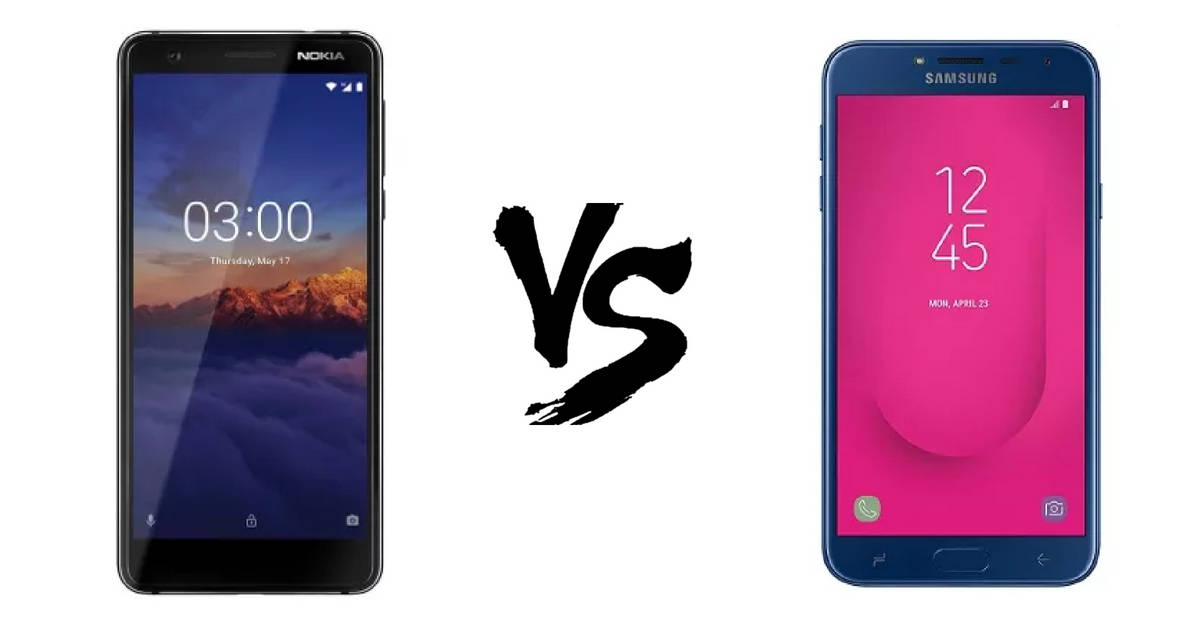
“Both smartphones are priced around Rs 10,000, but which one should you go for?”
With the launch of the Nokia 3.1, India has gotten its most affordable Android One smartphone to date. Nokia’s latest comes with a taller display than its predecessor and even features a slightly better processor. At Rs 10,499, this phone is competing directly with the Samsung Galaxy J4 (2018), which recently had its price slashed to Rs 9,490 for the 2GB RAM model. Those with a budget of around Rs 10,000 will indeed be confused about which phone to go for among these two. To resolve this dilemma, we pit the Nokia 3.1 against the Samsung Galaxy J4.
Table of Contents
Design and display

The Nokia 3.1 will immediately grab your attention with its sporty looks. The dual-tone finish can be seen not just on its back but also the front, as the frame gets a silver or gold coating. One thing you won’t find on the rear or the front surface is a fingerprint scanner however, as the phone gives it a miss, just like its predecessor. But this kind of gets nullified since the Galaxy J4 does not carry a fingerprint sensor either. The smartphone adopts the traditional Samsung looks, which doesn’t help it against Nokia 3.1’s attractive looks.
The J4 sports a 5.5-inch 720p Super AMOLED display. It’s definitely pleasing to see an affordable smartphone offering an OLED panel. In comparison, the Nokia 3.1 features a 5.2 inch IPS screen. Adhering to the market trend, the Nokia handset has adopted an 18:9 aspect ratio which takes its resolution to 720 x 1440 pixels. Giving the 3.1 another edge is a protective layer of Corning Gorilla Glass, which the Samsung device doesn’t have.
Hardware and software

The Samsung Galaxy J4 has gone for an in-house Exynos 7570 chipset, which comes with a quad-core chipset and Mali-T720 MP2 GPU. The Nokia 3.1 on the other hand, features an octa-core MediaTek MT6750 processor. Although the chip on Nokia’s offering seems better, at least on paper, both silicons are good for casual use only and aren’t meant for intensive tasks. Both the phones ship with 2GB of RAM and 16GB of storage (the J4 also comes with 3GB RAM and 32GB storage), which can be expanded further with the use of microSD cards.

Apart from an accelerometer, the Nokia 3.1 comes with a gyroscope, a compass, and a proximity sensor. As opposed to that, the Galaxy J4 just opts for an accelerometer and a proximity sensor. FM radio is present on both the phones, but USB OTG functionality is only available on the Nokia phone.
Nokia 3.1’s software is definitely its main draw, as Android One phones get monthly security patches for up to three years, as well as major Android updates for two years. That means, the smartphone is eligible for Android P and even the future Android Q update. Add to it the fact that the OS doesn’t come with a custom skin and bloatware, the phone promises smoother performance. The software on the Galaxy J4 is based on Android 8.0 Oreo, and comes with features like split-screen multitasking, AR filters, an intelligent gallery app and more. However, Samsung has rather had a rocky history when it comes to Android updates, which makes the 3.1 a better choice in this department.
Camera and battery

The Nokia 3.1 rocks a 13MP f/2.0 camera on the back. Same goes for the Samsung Galaxy J4, which too offers a 13MP snapper but with a f/1.9 aperture. While the camera on the former can just shoot 720p videos, the one on the latter offers 1080p video recording. The front of the 3.1 houses an 8MP camera, while that of the J4 is host to a 5MP camera along with a front-facing flash to click better selfies in low light.
In terms of the battery, the Nokia 3.1 has a 2,990mAh unit, while the Samsung handset has gone for a 3,000mAh cell. So they both offer pretty much the same amount of power.
Conclusion

While it’s a close fight, those torn between the Nokia 3.1 and the Samsung Galaxy J4 should definitely select the former. The Nokia smartphone has the advantage of Android One, boasts slightly better hardware, and has better looks too.











